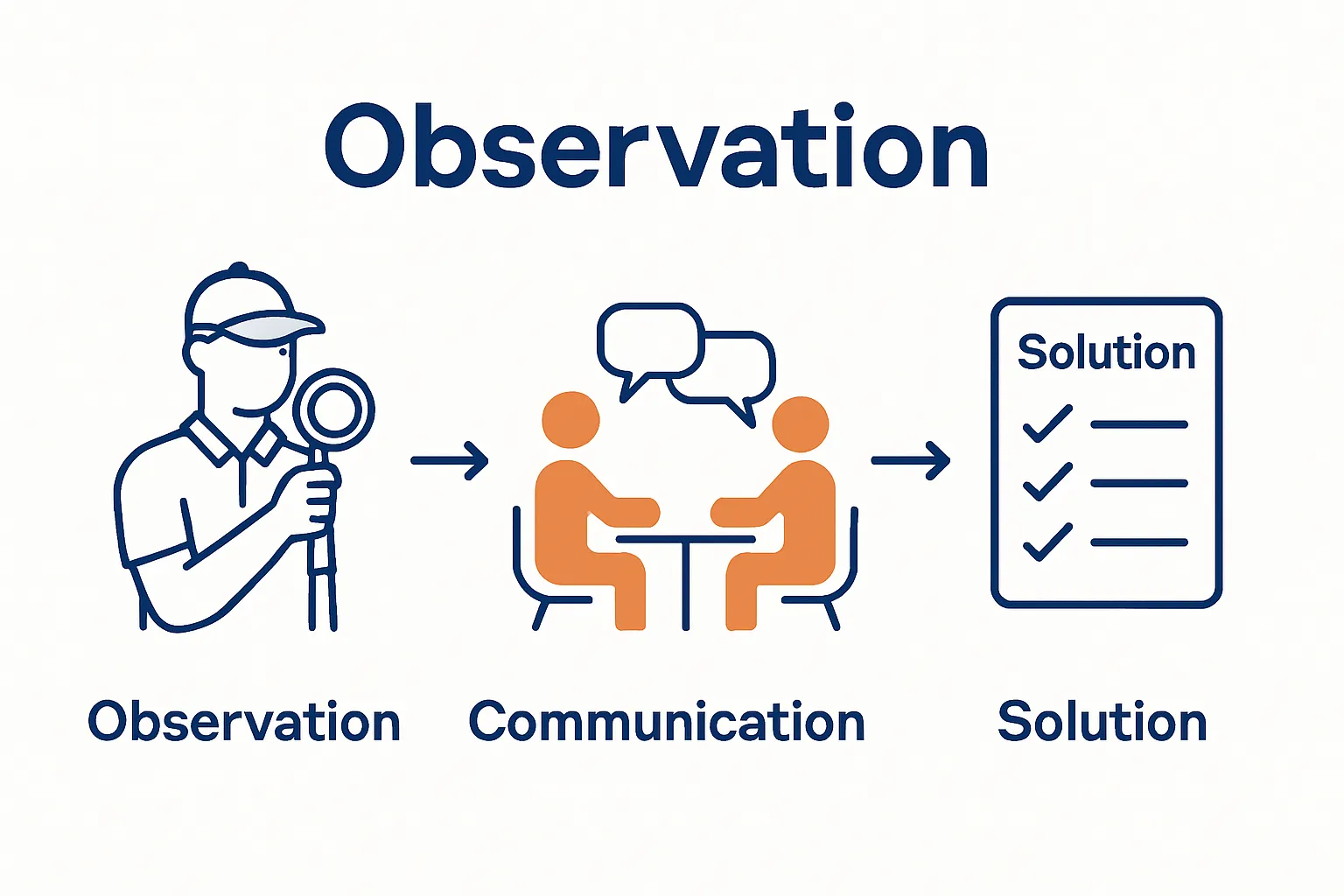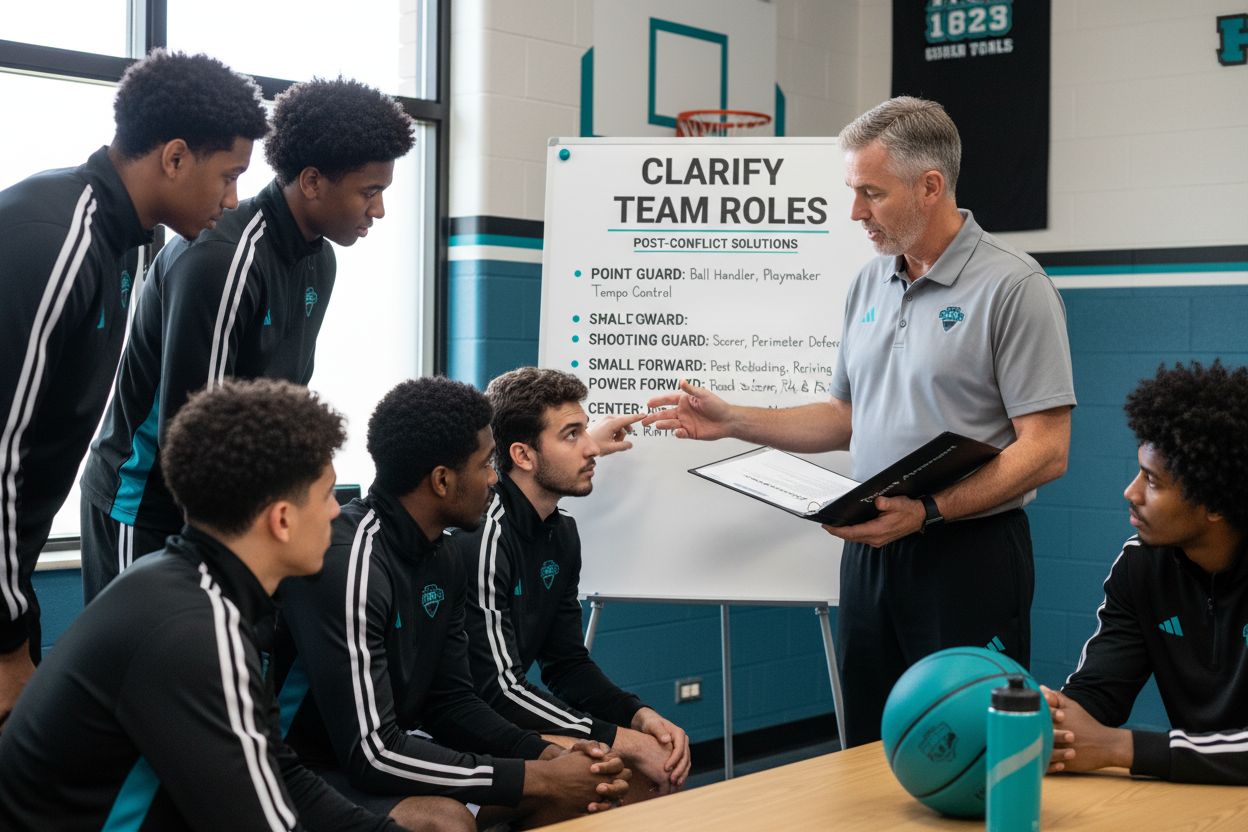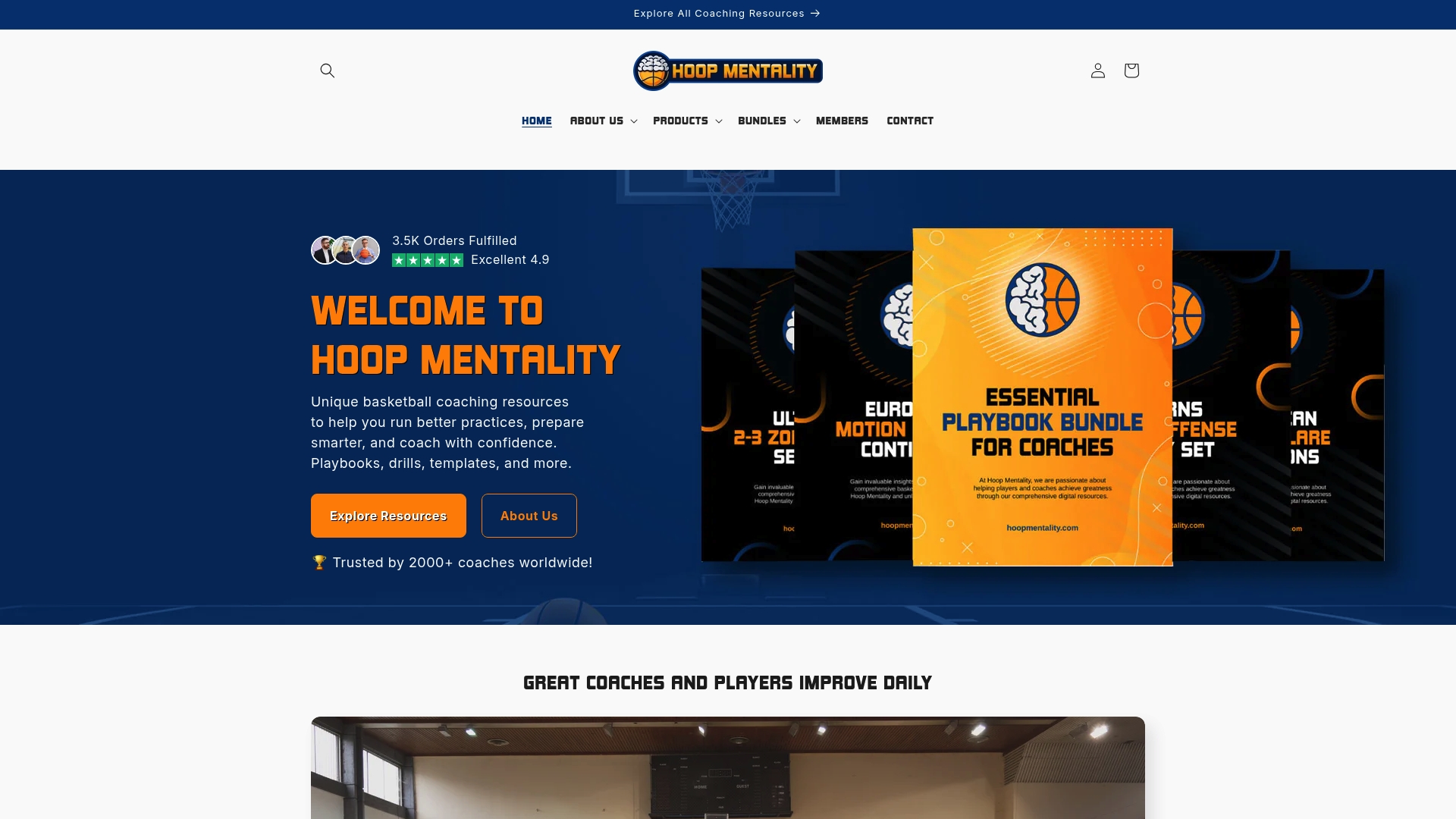Every winning basketball team depends on trust and communication, yet even the most talented squads face hidden tension beneath the surface. Surprise fact: one study found body language cues like avoiding eye contact often signal deeper conflicts long before an argument breaks out. Most people think strong teams are just about skill and hustle, but the real foundation is in how you handle disagreement and repair broken trust.
Table of Contents
- Step 1: Assess Team Dynamics And Identify Conflicts
- Step 2: Facilitate Open Communication Among Team Members
- Step 3: Mediate Conversations To Find Common Ground
- Step 4: Implement Solutions And Clarify Team Roles
- Step 5: Monitor Progress And Adjust Strategies As Needed
Quick Summary
| Key Point | Explanation |
|---|---|
| 1. Observe team interactions carefully | Monitor communication signals like body language to identify potential conflicts early. |
| 2. Foster open communication and trust | Create a safe environment for players to express concerns without fear of judgment. |
| 3. Utilize structured mediation techniques | Guide conflicted members using neutral discussions to facilitate mutual understanding. |
| 4. Clearly define team roles and expectations | Document specific responsibilities to prevent misunderstandings and future conflicts. |
| 5. Monitor progress and adapt strategies | Regularly assess team dynamics and adjust interventions to support ongoing improvement. |
Step 1: Assess Team Dynamics and Identify Conflicts
Identifying and understanding team conflict requires a strategic and nuanced approach. Before addressing any interpersonal challenges, coaches must develop a comprehensive view of their team’s current interaction patterns and potential friction points. Successful conflict resolution begins with careful observation and intentional assessment.
Understanding Team Communication Signals
Effective conflict assessment starts with keen observation of team interactions. Watch for subtle communication signals that reveal underlying tensions. These might include body language cues, such as players avoiding eye contact, displaying defensive postures, or exhibiting minimal engagement during team discussions. Listen carefully to tone and communication patterns during practice sessions and team meetings.
According to research from the Journal of Applied Psychology, team dynamics are complex systems where individual behaviors interconnect and create larger interaction patterns. Coaches must look beyond surface-level interactions to understand the root causes of potential conflicts.
Systematic Conflict Identification Strategies
To systematically identify conflicts, implement a multi-step observation process. Schedule periodic one-on-one meetings with team members to understand individual perspectives. During these conversations, create a safe environment where players feel comfortable sharing their experiences and concerns. Ask open-ended questions that encourage honest dialogue about team relationships and potential friction points.
Key areas to explore during these assessments include:
- Perceived inequities in playing time
- Communication breakdowns between players
- Differences in performance expectations
- Personal disagreements affecting team chemistry
Additionally, document your observations in a confidential team dynamics journal. Track patterns, recurring issues, and potential intervention strategies. This systematic approach transforms conflict identification from a reactive process to a proactive management strategy.

Successful conflict assessment requires patience, emotional intelligence, and a commitment to understanding the complex human dynamics within your team. By developing a nuanced understanding of team interactions, coaches can create targeted interventions that address conflicts constructively and maintain a positive team environment.
Below is a summary table outlining each main step in the conflict resolution process, including the goal and example action for each step.
| Step | Goal | Example Action |
|---|---|---|
| Assess Team Dynamics and Identify Conflicts | Recognize sources of tension and understand team interactions | Observe team meetings and conduct one-on-one player sessions |
| Facilitate Open Communication Among Team Members | Build trust and encourage players to express concerns openly | Hold structured roundtable discussions with balanced participation |
| Mediate Conversations to Find Common Ground | Guide team members to improved understanding and cooperation | Lead neutral mediation sessions focusing on shared goals |
| Implement Solutions and Clarify Team Roles | Formalize roles and create accountability for agreed actions | Draft a team agreement detailing roles and responsibilities |
| Monitor Progress and Adjust Strategies as Needed | Ensure solutions are effective and foster continuous improvement | Track communication patterns and schedule regular follow-up meetings |
Step 2: Facilitate Open Communication Among Team Members
Open communication transforms potential conflict zones into opportunities for team growth and understanding. Coaches play a critical role in creating an environment where players feel safe expressing concerns, sharing perspectives, and working through interpersonal challenges constructively. This step requires deliberate strategies and a commitment to building trust.
Creating a Safe Communication Environment
Establishing psychological safety is fundamental to facilitating open communication. Players must believe they can share their thoughts without fear of judgment or retribution. Begin by setting clear ground rules that emphasize respect, active listening, and constructive dialogue. Design team meetings and communication sessions that prioritize equal participation, ensuring every team member has an opportunity to speak and be heard.
According to communication skills research, effective communication relies on creating structured opportunities for dialogue. Coaches should implement regular team forums where players can discuss both performance and interpersonal dynamics openly.
Structured Communication Techniques
Implement specific communication techniques that encourage honest and productive exchanges. One powerful approach is the roundtable discussion method, where each player gets uninterrupted time to share their perspective. During these sessions, establish guidelines that prohibit interruptions, defensive responses, or personal attacks. Teach players to use “I” statements that focus on their personal experiences rather than accusatory language.
Key communication protocols include:
- Listening without interrupting
- Validating others’ experiences
- Focusing on solutions rather than blame
- Maintaining a respectful tone
Coaches who understand basketball leadership principles recognize that communication is a skill that requires continuous practice and refinement. By modeling effective communication and providing structured opportunities for dialogue, you create a team culture that values mutual understanding and collective problem solving.
Successful communication facilitation transforms potential conflicts into moments of team building. Remember that your role is not to eliminate all disagreements but to create a framework where differences can be discussed productively and resolved collaboratively.
Step 3: Mediate Conversations to Find Common Ground
Mediating team conflicts requires a delicate balance of neutrality, empathy, and strategic guidance. As a coach, your primary role is to transform potentially divisive interactions into opportunities for mutual understanding and collaborative problem solving. Effective mediation goes beyond simply resolving surface level disagreements and aims to rebuild team cohesion and trust.
Establishing Neutral Ground
Successful mediation begins by creating a neutral, structured environment where all team members feel equally respected and heard. Choose a setting that feels comfortable and non-threatening, preferably away from the typical practice or game spaces. Neutral territory helps players drop defensive barriers and approach conversations with more openness. Set clear ground rules that emphasize mutual respect, active listening, and a commitment to finding collective solutions.
According to conflict resolution research, successful mediation depends on the mediator’s ability to remain impartial and guide participants toward constructive dialogue.
Your role is not to judge or assign blame but to facilitate understanding.
Strategic Mediation Techniques
Develop a structured approach to guiding conflicting team members toward common ground. Begin by having each party articulate their perspective without interruption. Teach players to use “I” statements that express personal feelings and experiences rather than making accusatory claims. Encourage team members to listen actively, demonstrating understanding by paraphrasing what they have heard.
Key mediation strategies include:
- Identifying shared team goals
- Highlighting individual strengths
- Focusing on future collaboration
- Developing mutual accountability
Coaches who understand basketball leadership principles recognize that conflict resolution is an opportunity to strengthen team dynamics. By guiding players to recognize their interconnectedness and shared objectives, you transform potential divisions into moments of collective growth.
Verify successful mediation by observing subsequent team interactions. Look for signs of improved communication, increased mutual respect, and a renewed commitment to team goals. Remember that finding common ground is an ongoing process that requires patience, empathy, and a genuine belief in the team’s potential for unity.
Step 4: Implement Solutions and Clarify Team Roles
Transitioning from conflict identification to resolution requires strategic implementation of agreed-upon solutions and precise role definition. This crucial stage transforms dialogue into actionable outcomes that reinforce team unity and individual accountability. Coaches must approach this step with clarity, consistency, and a forward-looking perspective.
Defining Clear Team Expectations
Establishing crystal-clear expectations is fundamental to preventing future conflicts. After mediation, develop a team agreement document that outlines specific roles, responsibilities, and communication protocols. This living document should articulate each player’s contribution to team objectives, performance standards, and interpersonal conduct. Transparency is key in ensuring every team member understands their precise role and the collective expectations.

According to organizational behavior research, well-defined team roles significantly reduce ambiguity and potential friction. By explicitly mapping individual responsibilities, coaches can preemptively address potential sources of misunderstanding.
Structured Implementation and Accountability
Implement solutions through a phased approach that allows for continuous feedback and adjustment. Schedule regular check-in meetings to review progress, address emerging challenges, and reinforce the team’s commitment to collaborative problem solving. These sessions provide opportunities to celebrate improvements and make incremental refinements to team dynamics.
Key implementation strategies include:
- Creating individual development plans
- Establishing measurable performance metrics
- Defining consequences for not meeting team expectations
- Designing a supportive feedback mechanism
Coaches can enhance their team management by exploring our Player Code Of Conduct that establish clear behavioral expectations within the teams. Effective implementation is not about rigid control but about creating a flexible framework that empowers players to excel individually and collectively.

Successful role clarification and solution implementation require ongoing commitment. Verify progress by observing improved team communication, reduced friction, and a noticeable increase in collective performance. Remember that role clarity is a continuous process of communication, adjustment, and mutual understanding.
Here is a checklist table you can use to verify your progress in building a healthy, communicative team environment and resolving conflict proactively.
| Verification Step | What to Look For | How to Check |
|---|---|---|
| Early Conflict Detection | Signs of tension or disengagement | Observe body language and listen for tone changes |
| Open Communication | Players share concerns without fear | Monitor participation in team discussions |
| Successful Mediation Outcomes | Issues resolved and team cohesion improves | Note improvements in interactions after mediation |
| Role Clarity | Everyone understands assigned team roles | Confirm each player can state their responsibilities |
| Ongoing Progress Monitoring | Continuous improvement and reduced friction | Review tracking logs and feedback from check-in meetings |
Step 5: Monitor Progress and Adjust Strategies as Needed
Conflict resolution is not a one-time event but an ongoing process of observation, assessment, and strategic refinement. Coaches must develop a systematic approach to tracking team dynamics, evaluating the effectiveness of implemented solutions, and making nuanced adjustments that support continuous team growth and harmony.
Establishing Tracking Mechanisms
Develop a comprehensive monitoring system that captures both quantitative and qualitative insights into team interactions and performance. Consistent observation is critical to understanding the long-term impact of conflict resolution strategies. Create a confidential tracking log that documents team communication patterns, performance metrics, and interpersonal dynamics. This log should include specific notes on behavioral changes, communication improvements, and potential emerging tensions.
According to organizational psychology research, systematic monitoring allows leaders to identify subtle shifts in team dynamics before they escalate into significant conflicts. Your tracking approach should be both objective and empathetic.
Adaptive Strategy Refinement
Effective monitoring requires a flexible and responsive approach to strategy adjustment. Schedule regular team meetings and individual check-ins that provide opportunities for open feedback and continuous improvement. These sessions should allow players to share their experiences, discuss challenges, and collaboratively develop solutions. The key is creating an environment where adaptation is seen as a strength, not a weakness.
Critical monitoring strategies include:
- Conducting monthly team climate assessments
- Tracking individual and collective performance indicators
- Identifying patterns of communication and interaction
- Developing responsive intervention protocols
Coaches can enhance their monitoring capabilities by exploring time management techniques that support systematic team development. Remember that effective monitoring is about creating a culture of continuous learning and mutual respect.
Verify the success of your monitoring efforts by observing sustained improvements in team communication, reduced conflict frequency, and enhanced overall team performance. The ultimate goal is not to eliminate all disagreements but to create a team culture that can productively navigate and grow through challenges.
Ready to Resolve Team Conflict Like a Pro?
If you find yourself navigating tough team dynamics, struggling with player communication, or searching for a proven way to address and prevent conflict, you are not alone. Coaches often face challenges like clarifying roles, implementing effective solutions, and fostering open communication among players. The strategies described in our article mirror the real challenges coaches encounter on and off the court. Practical resources can make all the difference in taking your team from conflict to cohesion.

Take action today and explore the professional coaching tools at Hoop Mentality designed to support you through every step discussed in the article. Access detailed basketball playbook strategies to reinforce role clarity. Use our leadership tips to inspire trust and build a unified team culture. Don’t wait for conflict to hold your team back. Visit Hoop Mentality now to give your players the structure and confidence they need to thrive together.
Frequently Asked Questions
How can I assess team dynamics to identify conflicts?
Effective assessment starts with careful observation of team interactions. Look for body language cues, changes in communication patterns, and schedule one-on-one meetings to understand individual perspectives and concerns. Document your observations to track patterns and recurring issues.
What are some effective communication techniques for resolving team conflicts?
Implement structured communication methods, such as roundtable discussions where each player shares their perspective without interruption. Encourage the use of ‘I’ statements, active listening, and a focus on solutions rather than blame to foster productive dialogue.
What steps should I take to mediate conversations among team members?
Establish a neutral ground where all members feel respected, set clear ground rules, and guide participants through the dialogue. Encourage them to express their perspectives using ‘I’ statements and focus on common goals to rebuild team cohesion.
How do I monitor team progress after implementing conflict resolution strategies?
Create a comprehensive tracking system to capture team interactions and performance metrics. Schedule regular check-ins and team climate assessments to gather feedback and adjust strategies as needed to ensure continuous improvement.
Recommended
- 7 Essential Basketball Leadership Tips for Coaches – Hoop Mentality
- How to Boost Team Morale: 5 Psychology-Backed Strategies – Hoop Mentality
- Mastering Time Management for Coaches: Boost Efficiency – Hoop Mentality
- How To Develop Leadership Skills In Basketball Players? – Hoop Mentality
- Insubordination at Work: Meaning, Examples and Solutions - Rezound Career Coaching
- Master Team Scheduling Best Practices for Success - WhenNOT Blog

